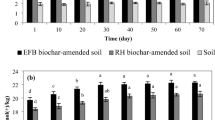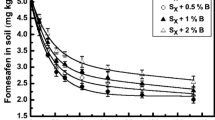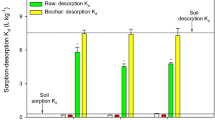Abstract
Application of biochar technology in the remediation of organic contaminated soils has drawn growing interest in recent years. In this study, sorption and degradation of two typical neonicotinoid insecticides, imidacloprid (IMI) and clothianidin (CLO) in Chinese typical paddy soil and red soil amended with six kinds of biochars were investigated. The results showed that surface area (SA), pH, total organic carbon and dissolved organic carbon (DOC) of the two soils all increased after biochar amendment, while H/C decreased. With biochar pyrolyzing temperature (PT) increasing from 300 °C to 700 °C, the sorption of the two insecticides on biochar–soil mixtures increased by more than 4.3-fold, due to the increasing SA and decreasing H/C. The acidic pH of the two tested soils also favored the enhanced sorption of the insecticides by removing the ash on biochar. The amendment of low-PT (300 °C) biochar promoted the biodegradation of IMI and CLO by 11.3–41.9% via providing more DOC and available N for microorganisms, while inhibiting the chemical degradation. Oppositely, the high-PT (500–700 °C) biochars inhibited the biodegradation of the insecticides by decreasing their bioavailability and promoted the chemical degradation by providing mineral active groups, and generating ·OH and other free radicals. In addition, soil type also affected the effects of biochar remediation. The highest 60-day degradation extent was achieved for CLO (90.5%) and IMI (81.4%) in paddy soil by adding biochar derived from pig manure at 700 °C PT. In summary, the effect of biochar on the fate of organic contaminants in soil is a comprehensive result involving several processes and a systematic study considering the type and property of biochar and soil is needed to optimize biochar technology.



Similar content being viewed by others
References
Anderson JC, Dubetz C, Palace VP (2015) Neonicotinoids in the Canadian aquatic environment: a literature review on current use products with a focus on fate, exposure, and biological effects. Sci Total Environ 505:409–422. https://doi.org/10.1016/j.scitotenv.2014.09.090
Andert J, Mumme J (2015) Impact of pyrolysis and hydrothermal biochar on gas-emitting activity of soil microorganisms and bacterial and archaeal community composition. Appl Soil Ecol 96:225–239. https://doi.org/10.1016/j.apsoil.2015.08.019
Botias C, David A, Horwood J, Abdul-Sada A, Nicholls E, Hill E, Goulson D (2015) Neonicotinoid residues in wildflowers, a potential route of chronic exposure for bees. Environ Sci Technol 49:12731–12740. https://doi.org/10.1021/acs.est.5b03459
Chai Y, Currie RJ, Davis JW, Wilken M, Martin GD, Fishman VN, Ghosh U (2012) Effectiveness of activated carbon and biochar in reducing the availability of polychlorinated dibenzo-p-dioxins/dibenzofurans in soils. Environ Sci Technol 46:1035–1043. https://doi.org/10.1021/es2029697
Chen J, Sun X, Li L, Liu X, Zhang B, Zheng J, Pan G (2016) Change in active microbial community structure, abundance and carbon cycling in an acid rice paddy soil with the addition of biochar. Eur J Soil Sci 67:857–867. https://doi.org/10.1111/ejss.12388
Fang G, Gao J, Liu C, Dionysiou DD, Wang Y, Zhou D (2014) Key role of persistent free radicals in hydrogen peroxide activation by biochar: implications to organic contaminant degradation. Environ Sci Technol 48:1902–1910. https://doi.org/10.1021/es4048126
Fang G, Zhu C, Dionysiou DD, Gao J, Zhou D (2015a) Mechanism of hydroxyl radical generation from biochar suspensions: implications to diethyl phthalate degradation. Bioresour Technol 176:210–217. https://doi.org/10.1016/j.biortech.2014.11.032
Fang G, Liu C, Gao J, Dionysiou DD, Zhou D (2015b) Manipulation of persistent free radicals in biochar to activate persulfate for contaminant degradation. Environ Sci Technol 49:5645–5653. https://doi.org/10.1021/es5061512
Hallmann CA, Foppen RP, van Turnhout CA, de Kroon H, Jongejans E (2014) Declines in insectivorous birds are associated with high neonicotinoid concentrations. Nature 511:341–343. https://doi.org/10.1038/nature13531
Han D et al (2017) Degradation of dimethyl disulphide in soil with or without biochar amendment. Pest Manag Sci 73:1830–1836. https://doi.org/10.1002/ps.4545
Hartley W, Riby P, Waterson J (2016) Effects of three different biochars on aggregate stability, organic carbon mobility and micronutrient bioavailability. J Environ Manage 181:770–778. https://doi.org/10.1016/j.jenvman.2016.07.023
Jeschke P, Nauen R, Schindler M, Elbert A (2011) Overview of the status and global strategy for neonicotinoids. J Agric Food Chem 59:2897–2908. https://doi.org/10.1021/jf101303g
Jiao S, Liu Z, Lin Y, Yang J, Chen W, Wei G (2016) Bacterial communities in oil contaminated soils: Biogeography and co-occurrence patterns. Soil Biol Biochem 98:64–73
** J, Kang M, Sun K, Pan Z, Wu F, **ng B (2016) Properties of biochar-amended soils and their sorption of imidacloprid, isoproturon, and atrazine. Sci Total Environ 550:504–513. https://doi.org/10.1016/j.scitotenv.2016.01.117
Jones DL, Edwards-Jones G, Murphy DV (2011) Biochar mediated alterations in herbicide breakdown and leaching in soil. Soil Biol Biochem 43:804–813. https://doi.org/10.1016/j.soilbio.2010.12.015
Keiluweit M, Nico PS, Johnson MG, Kleber M (2010) Dynamic molecular structure of plant biomass-derived black carbon (biochar). Environ Sci Technol 44:1247–1253
Kessler SC et al (2015) Bees prefer foods containing neonicotinoid pesticides. Nature 521:74–76. https://doi.org/10.1038/nature14414
Khorram MS, Zhang Q, Lin D, Zheng Y, Fang H, Yu Y (2016) Biochar: a review of its impact on pesticide behavior in soil environments and its potential applications. J Environ Sci 44:269–279. https://doi.org/10.1016/j.jes.2015.12.027
Lattao C, Cao X, Mao J, Schmidt-Rohr K, Pignatello JJ (2014) Influence of molecular structure and adsorbent properties on sorption of organic compounds to a temperature series of wood chars. Environ Sci Technol 48:4790–4798. https://doi.org/10.1021/es405096q
Liu W, Zheng W, Ma Y, Liu KK (2006) Sorption and degradation of imidacloprid in soil and water. J Environ Sci Health Part B 41:623–634. https://doi.org/10.1080/03601230600701775
Lun L et al (2020) Application of biochar-based materials in environmental remediation: from multi-level structures to specific devices. Biochar. https://doi.org/10.1007/s42773-020-00041-7
Mandal A, Singh N (2017) Optimization of atrazine and imidacloprid removal from water using biochars: designing single or multi-staged batch adsorption systems. Int J Hyg Environ Health 220:637–645. https://doi.org/10.1016/j.ijheh.2017.02.010
Mandal A, Singh N, Purakayastha TJ (2017) Characterization of pesticide sorption behaviour of slow pyrolysis biochars as low cost adsorbent for atrazine and imidacloprid removal. Sci Total Environ 577:376–385. https://doi.org/10.1016/j.scitotenv.2016.10.204
Martin SM, Kookana RS, Van Zwieten L, Krull E (2012) Marked changes in herbicide sorption-desorption upon ageing of biochars in soil. J Hazard Mater 231–232:70–78. https://doi.org/10.1016/j.jhazmat.2012.06.040
Morrissey CA, Mineau P, Devries JH, Sanchez-Bayo F, Liess M, Cavallaro MC, Liber K (2015) Neonicotinoid contamination of global surface waters and associated risk to aquatic invertebrates: a review. Environ Int 74:291–303. https://doi.org/10.1016/j.envint.2014.10.024
Mukherjee A, Zimmerman AR (2013) Organic carbon and nutrient release from a range of laboratory-produced biochars and biochar–soil mixtures. Geoderma 193–194:122–130. https://doi.org/10.1016/j.geoderma.2012.10.002
Oleszczuk P, Jośko I, Futa B, Pasieczna-Patkowska S, Pałys E, Kraska P (2014) Effect of pesticides on microorganisms, enzymatic activity and plant in biochar-amended soil. Geoderma 214–215:10–18. https://doi.org/10.1016/j.geoderma.2013.10.010
Qiang H, Shuang S, Zhe C, Baowei H, Jianrong C, **angke W (2019) Biochar-based materials and their applications in removal of organic contaminants from wastewater: state-of-the-art review. Biochar 1:45–73. https://doi.org/10.1007/s42773-019-00006-5
Ren G, Ren W, Teng Y, Li Z (2015) Evident bacterial community changes but only slight degradation when polluted with pyrene in a red soil. Front Microbiol 6:22. https://doi.org/10.3389/fmicb.2015.00022
Ren X, Zhang P, Zhao L, Sun H (2016a) Sorption and degradation of carbaryl in soils amended with biochars: influence of biochar type and content. Environ Sci Pollut Res Int 23:2724–2734. https://doi.org/10.1007/s11356-015-5518-z
Ren G, Teng Y, Ren W, Dai S, Li Z (2016b) Pyrene dissipation potential varies with soil type and associated bacterial community changes. Soil Biol Biochem 103:71–85. https://doi.org/10.1016/j.soilbio.2016.08.007
Ren X et al (2017) Sorption, transport and biodegradation—an insight into bioavailability of persistent organic pollutants in soil. Sci Total Environ 610–611:1154–1163. https://doi.org/10.1016/j.scitotenv.2017.08.089
Ren X, Wang F, Zhang P, Guo J, Sun H (2018a) Aging effect of minerals on biochar properties and sorption capacities for atrazine and phenanthrene. Chemosphere 206:51–58. https://doi.org/10.1016/j.chemosphere.2018.04.125
Ren X, Sun H, Wang F, Zhang P, Zhu H (2018b) Effect of aging in field soil on biochar's properties and its sorption capacity. Environ Pollut 242:1880–1886. https://doi.org/10.1016/j.envpol.2018.07.078
Rundlof M et al (2015) Seed coating with a neonicotinoid insecticide negatively affects wild bees. Nature 521:77–80. https://doi.org/10.1038/nature14420
Shainberg I (1973) Rate and mechanisms of Na-montmorillonite hydrolysis in suspension. Soil Sci Soc Am Proc 5:689–694
Sigmund G, Gharasoo M, Hüffer T, Hofmann T (2020) Deep learning neural network approach for predicting the sorption of ionizable and polar organic pollutants to a wide range of carbonaceous materials. Environ Sci Technol 54:4583–4591. https://doi.org/10.1021/acs.est.9b06287
Sohi S (2010) Carbon storage with benefits. Science 338:1034–1035
Sun K et al (2013) Impact of deashing treatment on biochar structural properties and potential sorption mechanisms of phenanthrene. Environ Sci Technol 47:11473–11481. https://doi.org/10.1021/es4026744
Tong H, Hu M, Li FB, Liu CS, Chen MJ (2014) Biochar enhances the microbial and chemical transformation of pentachlorophenol in paddy soil. Soil Biol Biochem 70:142–150. https://doi.org/10.1016/j.soilbio.2013.12.012
Trigo C, Spokas KA, Cox L, Koskinen WC (2014) Influence of soil biochar aging on sorption of the herbicides MCPA, nicosulfuron, terbuthylazine, indaziflam, and fluoroethyldiaminotriazine. J Agric Food Chem 62:10855–10860. https://doi.org/10.1021/jf5034398
Wang J, Chen J, Zhu W, Ma J, Rong Y, Cai Z (2016) Isolation of the novel chiral insecticide paichongding (IPP) degrading strains and biodegradation pathways of RR/SS-IPP and SR/RS-IPP in an aqueous system. J Agric Food Chem 64:7431–7437. https://doi.org/10.1021/acs.jafc.6b02862
Wang N, Chang ZZ, Xue XM, Yu JG, Shi XX, Ma LQ, Li HB (2017) Biochar decreases nitrogen oxide and enhances methane emissions via altering microbial community composition of anaerobic paddy soil. Sci Total Environ 581–582:689–696. https://doi.org/10.1016/j.scitotenv.2016.12.181
Xu N, Tan G, Wang H, Gai X (2016) Effect of biochar additions to soil on nitrogen leaching, microbial biomass and bacterial community structure. Eur J Soil Biol 74:1–8. https://doi.org/10.1016/j.ejsobi.2016.02.004
Yang J, Pan B, Li H, Liao S, Zhang D, Wu M, **ng B (2016) Degradation of p-nitrophenol on biochars: role of persistent free radicals. Environ Sci Technol 50:694–700. https://doi.org/10.1021/acs.est.5b04042
Yavari S, Malakahmad A, Sapari NB (2015) Biochar efficiency in pesticides sorption as a function of production variables—a review. Environ Sci Pollut Res Int 22:13824–13841. https://doi.org/10.1007/s11356-015-5114-2
Yokoyama S, Yuri K, Nomi T, Komine M, Nakamura S, Hattori H, Rai H (2017) The high correlation between DNA and chloroform-labile N in various types of soil. Appl Soil Ecol 117–118:1–9. https://doi.org/10.1016/j.apsoil.2017.04.002
Yuan JH, Xu RK, Zhang H (2011) The forms of alkalis in the biochar produced from crop residues at different temperatures. Bioresour Technol 102:3488–3497. https://doi.org/10.1016/j.biortech.2010.11.018
Zhang P, Sun H, Yu L, Sun T (2013) Adsorption and catalytic hydrolysis of carbaryl and atrazine on pig manure-derived biochars: impact of structural properties of biochars. J Hazard Mater 244–245:217–224. https://doi.org/10.1016/j.jhazmat.2012.11.046
Zhang P, Zhang X, Zhao Y, Wei Y, Mu W, Liu F (2016) Effects of imidacloprid and clothianidin seed treatments on wheat aphids and their natural enemies on winter wheat. Pest Manag Sci 72:1141–1149. https://doi.org/10.1002/ps.4090
Zhang P, Sun H, Ren C, Min L, Zhang H (2018a) Sorption mechanisms of neonicotinoids on biochars and the impact of deashing treatments on biochar structure and neonicotinoids sorption. Environ Pollut 234:812–820. https://doi.org/10.1016/j.envpol.2017.12.013
Zhang P, Sun H, Min L, Ren C (2018b) Biochars change the sorption and degradation of thiacloprid in soil: Insights into chemical and biological mechanisms. Environ Pollut 236:158–167. https://doi.org/10.1016/j.envpol.2018.01.030
Zhang P, Ren C, Sun H, Min L (2018c) Sorption, desorption and degradation of neonicotinoids in four agricultural soils and their effects on soil microorganisms. Sci Total Environ 615:59–69. https://doi.org/10.1016/j.scitotenv.2017.09.097
Zhang P, Huang P, Xu X, Sun H, Jiang B, Liao Y (2020) Spectroscopic and molecular characterization of biochar-derived dissolved organic matter and the associations with soil microbial responses. Sci Total Environ 708:134619. https://doi.org/10.1016/j.scitotenv.2019.134619
Acknowledgements
This work was supported by the National Key R&D Program of China (2018YFC1802001), the special fund of platform for innovation of Tian** Science and Technology Commission (19PTZWHZ00040), Science and Technology Major Project of Tian** (19ZXSZSN00010) and Postdoctoral Science Foundation of China (2019M651018) and Ministry of Education of China (111 program, T2017002).
Author information
Authors and Affiliations
Corresponding author
Ethics declarations
Conflict of interest
The authors declare no competing financial interest.
Electronic supplementary material
Below is the link to the electronic supplementary material.
Rights and permissions
About this article
Cite this article
Zhang, P., Min, L., Tang, J. et al. Sorption and degradation of imidacloprid and clothianidin in Chinese paddy soil and red soil amended with biochars. Biochar 2, 329–341 (2020). https://doi.org/10.1007/s42773-020-00060-4
Received:
Accepted:
Published:
Issue Date:
DOI: https://doi.org/10.1007/s42773-020-00060-4




